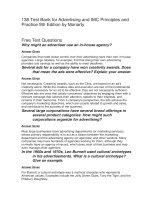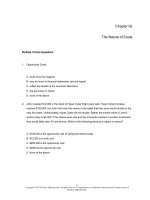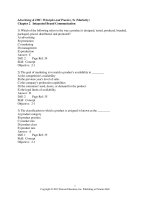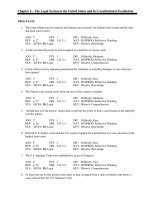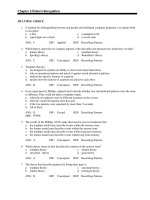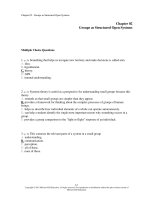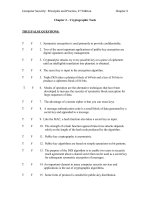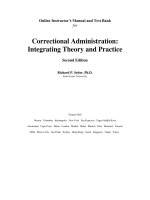Entrepreneurship theory process and practice 9th edition kuratko test bank
Bạn đang xem bản rút gọn của tài liệu. Xem và tải ngay bản đầy đủ của tài liệu tại đây (170.05 KB, 15 trang )
CHAPTER 2: THE ENTREPRENEURIAL MIND-SET IN INDIVIDUALS:
COGNITION AND ETHICS
TRUE/FALSE
1. Each and every person has the potential and free choice to pursue a career as an entrepreneur.
ANS: T
PTS: 1
NAT: AACSB Reflective Thinking | Motivation Concepts
2. The generation of the twenty-first century may become known as generation E because it is becoming
the most entrepreneurial generation since the Industrial Revolution.
ANS: T
PTS: 1
NAT: AACSB Reflective Thinking | Motivation Concepts
3. Entrepreneurial cognition is, in part, about understanding how entrepreneurs use simplifying mental
models to make assessments, judgments, and decisions about opportunities.
ANS: T
PTS: 1
NAT: AACSB Reflective Thinking | Motivation Concepts
4. The metacognitive model of entrepreneurship fails to consider entrepreneurial motivation.
ANS: F
PTS: 1
NAT: AACSB Reflective Thinking | Motivation Concepts
5. Entrepreneurs are pessimists who see the cup half empty, rather than half full.
ANS: F
PTS: 1
NAT: AACSB Reflective Thinking | Motivation Concepts
6. Inexperience and incompetent management are the main reasons for failure.
ANS: T
PTS: 1
NAT: AACSB Reflective Thinking | Motivation Concepts
7. A good trait for an entrepreneur is to be a calculated risk taker.
ANS: T
PTS: 1
NAT: AACSB Reflective Thinking | Motivation Concepts
8. Most successful entrepreneurs have failed at one time or another.
ANS: T
PTS: 1
NAT: AACSB Reflective Thinking | Motivation Concepts
9. Entrepreneurs do not need foresight.
ANS: F
PTS: 1
NAT: AACSB Reflective Thinking | Motivation Concepts
10. Entrepreneurs typically have enough confidence to believe that they can make a difference in the final
outcome of their ventures.
ANS: T
PTS: 1
NAT: AACSB Reflective Thinking | Motivation Concepts
11. Commitment, determination, and perseverance are the only characteristics one needs to become a
successful entrepreneur.
ANS: F
PTS: 1
NAT: AACSB Reflective Thinking | Motivation Concepts
12. Creativity was once regarded as an exclusively inherited trait.
ANS: T
PTS: 1
NAT: AACSB Reflective Thinking | Motivation Concepts
13. Selfishness and a need for power are two characteristics common in entrepreneurs.
ANS: F
PTS: 1
NAT: AACSB Reflective Thinking | Motivation Concepts
14. Successful entrepreneurs fear failure the same way all people do.
ANS: F
PTS: 1
NAT: AACSB Reflective Thinking | Motivation Concepts
15. Entrepreneurs are fiercely independent but understand the need for a strong entrepreneurial team.
ANS: T
PTS: 1
NAT: AACSB Reflective Thinking | Motivation Concepts
16. Entrepreneurs usually have an internal locus of control.
ANS: T
PTS: 1
NAT: AACSB Reflective Thinking | Motivation Concepts
17. There are many risks in entrepreneurship.
ANS: T
PTS: 1
NAT: AACSB Reflective Thinking | Motivation Concepts
18. There is a certain psychic risk involved with entrepreneurship.
ANS: T
PTS: 1
NAT: AACSB Reflective Thinking | Motivation Concepts
19. Some of the most common entrepreneurial goals are independence, wealth, and work satisfaction.
ANS: T
PTS: 1
NAT: AACSB Reflective Thinking | Motivation Concepts
20. Immersion in business can be cured by limiting work to an eight hour day.
ANS: F
PTS: 1
NAT: AACSB Reflective Thinking | Motivation Concepts
21. The need to achieve can be a source of stress for entrepreneurs.
ANS: T
PTS: 1
NAT: AACSB Reflective Thinking | Motivation Concepts
22. Stress on the entrepreneur can be caused both internally and by other people.
ANS: T
PTS: 1
NAT: AACSB Reflective Thinking | Motivation Concepts
23. The entrepreneur is driven by a strong desire for control over their venture.
ANS: T
PTS: 1
NAT: AACSB Reflective Thinking | Motivation Concepts
24. The “dark side” of entrepreneurship refers to the stress that entrepreneur’s experience.
ANS: F
PTS: 1
NAT: AACSB Reflective Thinking | Motivation Concepts
25. Entrepreneurs always know that they as individuals must remain less important than the venture.
ANS: F
PTS: 1
NAT: AACSB Reflective Thinking | Motivation Concepts
26. Entrepreneurs like to remain alert to competition, customers, and government regulations, but this
continual scanning of the environment can lead to a negative sense of distrust.
ANS: T
PTS: 1
NAT: AACSB Reflective Thinking | Motivation Concepts
27. Entrepreneurs are often unrealistically optimistic.
ANS: T
PTS: 1
NAT: AACSB Reflective Thinking | Motivation Concepts
28. According to the Model of Entrepreneurship Motivation, the entrepreneur’s expectations are not
compared with the actual or perceived outcomes of the firm.
ANS: F
PTS: 1
NAT: AACSB Reflective Thinking | Motivation Concepts
29. A loss orientation toward grief recovery in dealing with failure can sometimes lessen negative
emotional reactions.
ANS: F
PTS: 1
NAT: AACSB Reflective Thinking | Motivation Concepts
30. The Greek thinker, Chilon, felt that a merchant does better to take a loss than to make a dishonest
profit.
ANS: T
PTS: 1
NAT: AACSB Diversity | Ethical Responsibilities
31. Today’s entrepreneurs are faced with few ethical decisions because the legal system imposes greater
penalties on wrongdoers.
ANS: F
PTS: 1
NAT: AACSB Diversity | Ethical Responsibilities
32. “Ethos” means morality.
ANS: F
PTS: 1
NAT: AACSB Diversity | Ethical Responsibilities
33. Ethics provides the basic rules or parameters for conducting any activity in an “acceptable” manner.
ANS: T
PTS: 1
NAT: AACSB Diversity | Ethical Responsibilities
34. Ethics represents a set of principles prescribing a behavioral code that does not include moral duty and
obligations.
ANS: F
PTS: 1
NAT: AACSB Diversity | Ethical Responsibilities
35. Non-role acts are those acts against a firm in which the person fails to perform his or her managerial
role.
ANS: F
PTS: 1
NAT: AACSB Diversity | Ethical Responsibilities
36. Role distortion deals with morally questionable acts that are committed “for the firm.”
ANS: T
PTS: 1
NAT: AACSB Diversity | Ethical Responsibilities
37. Problems can arise when people believe that laws represent morality.
ANS: T
PTS: 1
NAT: AACSB Diversity | Ethical Responsibilities
38. Morals and law are not synonymous but may be viewed as two circles that are partially superimposed
upon each other.
ANS: T
PTS: 1
NAT: AACSB Diversity | Ethical Responsibilities
39. A code of conduct is a statement of ethical practices or guidelines to which an enterprise adheres.
ANS: T
PTS: 1
NAT: AACSB Diversity | Ethical Responsibilities
40. Entrepreneurs need not be concerned with establishing strategy for ethical responsibility because they
are guided by what established firms do.
ANS: F
PTS: 1
NAT: AACSB Diversity | Ethical Responsibilities
41. Institutionalization is a deliberate step to incorporate the ethical objectives of society with the
economic objectives of the venture.
ANS: F
PTS: 1
NAT: AACSB Diversity | Ethical Responsibilities
42. Firms need to be public about their ethical values and expectations.
ANS: T
PTS: 1
NAT: AACSB Diversity | Ethical Responsibilities
43. One of the most important reasons firms want to adhere to a high moral code is that doing so protects
free markets and is good business.
ANS: T
PTS: 1
NAT: AACSB Diversity | Ethical Responsibilities
44. An entrepreneur can never be certain what actual ethical consequences a decision will have.
ANS: T
PTS: 1
NAT: AACSB Diversity | Ethical Responsibilities
MULTIPLE CHOICE
1. Every person has the _____ and _____ to pursue a career as an entrepreneur
a. stubbornness; stupidity
b. potential; free choice
c. rights; regulations
d. obligation; duty
ANS: B
PTS: 1
NAT: AACSB Reflective Thinking | Motivation Concepts
2. Entrepreneurs
a. are driven by intense commitment and perseverance.
b. are egomaniacs.
c. loners who never fit in to typical firms.
d. are never satisfied.
ANS: A
PTS: 1
NAT: AACSB Reflective Thinking | Motivation Concepts
3. Characteristics often attributed to the entrepreneur include:
a. Commitment, determination, and perseverance
b. Prefers to be a loner
c. Power hungry
d. Ability to be indecisive
ANS: A
PTS: 1
NAT: AACSB Reflective Thinking | Motivation Concepts
4. Which is not a trait of a successful entrepreneur?
a. desire to achieve
b. initiative
c. innovation
d. trouble fitting in
ANS: D
PTS: 1
NAT: AACSB Reflective Thinking | Motivation Concepts
5. Entrepreneurs with a drive to achieve want to
a. compete.
b. watch others succeed.
c. take great risks.
d. control and dominate.
ANS: A
PTS: 1
NAT: AACSB Reflective Thinking | Motivation Concepts
6. Which of the following is not a trait of successful entrepreneurs?
a. initiative
b. frustration
c. perseverance
d. strategic thinking
ANS: B
PTS: 1
NAT: AACSB Reflective Thinking | Motivation Concepts
7. With persistent problem solving, entrepreneurs
a. must daydream all day.
b. can’t multi-task.
c. think anything is possible.
d. are always working.
ANS: C
PTS: 1
NAT: AACSB Reflective Thinking | Motivation Concepts
8. One could correlate _____ with a high energy level.
a. creativity
b. working
c. luck
d. reading
ANS: A
PTS: 1
NAT: AACSB Reflective Thinking | Motivation Concepts
9. For entrepreneurs, vision describes
a. where the entrepreneur wants to go.
b. eyesight.
c. people.
d. the future.
ANS: A
PTS: 1
NAT: AACSB Reflective Thinking | Motivation Concepts
10. Team building
a. involves including qualified people in the venture.
b. does not threaten the entrepreneur’s autonomy.
c. does nothing.
d. is overrated.
ANS: A
PTS: 1
NAT: AACSB Reflective Thinking | Motivation Concepts
11. A clear pattern among successful entrepreneurs is
a. setting goals that are just out of reach.
b. the fear of failure common to all people.
c. their focus on opportunity rather than resources.
d. not fitting in to traditional organizations.
ANS: C
PTS: 1
NAT: AACSB Reflective Thinking | Motivation Concepts
12. Which of the following is a false statement about entrepreneurs?
a. They burn with the competitive desire to excel.
b. They see the cup half full rather than half empty.
c. They do not use failure as a tool for learning.
d. They are achievers.
ANS: C
PTS: 1
NAT: AACSB Reflective Thinking | Motivation Concepts
13. One factor not found in high achievers is
a. responsibility.
b. failure to listen to feedback.
c. moderate risk taking.
d. high risk taking.
ANS: B
PTS: 1
NAT: AACSB Reflective Thinking | Motivation Concepts
14. Which of the following is not a common characteristic of entrepreneurs?
a. vision
b. team building
c. lack of motivational drive
d. independence
ANS: C
PTS: 1
NAT: AACSB Reflective Thinking | Motivation Concepts
15. Which of the following statements is false?
a. Entrepreneurs are born with the skills necessary to manage a business.
b. Their belief in their ability seldom wavers.
c. Independence is a driving force behind contemporary entrepreneurs.
d. Entrepreneurs know where they want to go.
ANS: A
PTS: 1
NAT: AACSB Reflective Thinking | Motivation Concepts
16. Which of the following is a true statement about team building?
a. Most successful entrepreneurs have highly qualified teams that handle everything having
to do with the development of the venture.
b. Compared to the owner, personnel are often more qualified to handle day-to-day
implementation challenges.
c. The entrepreneur has the clearest vision in the firm.
d. The entrepreneur needs a competent team to implement an idea.
ANS: D
PTS: 1
NAT: AACSB Reflective Thinking | Motivation Concepts
17. Which of the following statements is false?
a. Entrepreneurs want the authority to make important decisions.
b. Management skills are not important characteristics for entrepreneurs to possess.
c. Successful entrepreneurs strive to build a successful team around them.
d. An entrepreneur can develop the vision of the company over time.
ANS: B
PTS: 1
NAT: AACSB Reflective Thinking | Motivation Concepts
18. When entrepreneurs believe that their accomplishments and setbacks are within their own control and
influence, they are exhibiting
a. persistent problem-solving.
b. internal locus of control.
c. external locus of control.
d. opportunity orientation.
ANS: B
PTS: 1
NAT: AACSB Reflective Thinking | Motivation Concepts
19. If an entrepreneur believes in himself/herself and that their accomplishments and setbacks are within
their own control, they possess a (n) _____.
a. confidence level higher than most entrepreneurs
b. internal locus of control
c. cockiness level too high to be an entrepreneur
d. high energy level
ANS: B
PTS: 1
NAT: AACSB Reflective Thinking | Motivation Concepts
20. Which of the following is not associated with an entrepreneur seeking feedback?
a. entrepreneurs want to belittle their competition
b. entrepreneurs seek to learn from their competitors
c. entrepreneurs want to improve
d. entrepreneurs have a strong desire to know how well they are doing
ANS: A
PTS: 1
NAT: AACSB Reflective Thinking | Motivation Concepts
21. One trait not common in entrepreneurs is:
a. entrepreneurs are problem solvers
b. entrepreneurs are creative and innovative
c. entrepreneurs need structure
d. entrepreneurs are independent, yet like to build strong teams
ANS: C
PTS: 1
NAT: AACSB Reflective Thinking | Motivation Concepts
22. What characteristic(s) that propel entrepreneurs into success can be exhibited to the “extreme”?
a. Overbearing need for control
b. Optimism
c. High energy
d. Desire for success
e. Perseverance
ANS: A
PTS: 1
NAT: AACSB Reflective Thinking | Motivation Concepts
23. Areas of risk to the entrepreneur include
a. career, family, psychic.
b. family, business, social.
c. psychic, social, physical.
d. financial, product, market
ANS: A
PTS: 1
NAT: AACSB Reflective Thinking | Motivation Concepts
24. With psychic risk you fear
a. losing your sanity
b. failure.
c. money
d. adapting.
ANS: B
PTS: 1
NAT: AACSB Reflective Thinking | Motivation Concepts
25. In starting or buying a new business, the higher the rewards, the
a. the more minimal the risk.
b. greater the risk.
c. greater the size of a business.
d. smaller the enjoyment.
ANS: B
PTS: 1
NAT: AACSB Reflective Thinking | Motivation Concepts
26. Which of the following may be the greatest risk to the well-being of the entrepreneur?
a. social risk
b. financial risk
c. psychic risk
d. family risk
ANS: C
PTS: 1
NAT: AACSB Reflective Thinking | Motivation Concepts
27. In the Monroy-Folger Model of Risk Typology, profit-seeking activity is associated with:
a. strong desire to maximize profit
b. weaker desire to maximize profit
c. strong desire to minimize profit
d. strong desire to maximize sales revenue
ANS: A
PTS: 1
NAT: AACSB Reflective Thinking | Motivation Concepts
28. Generally, entrepreneurial stress is due to
a. being surrounded by incompetents.
b. fear of failure.
c. the discrepancy between the entrepreneur’s expectations and the ability to meet demands.
d. caused by a big ego.
ANS: C
PTS: 1
NAT: AACSB Reflective Thinking | Motivation Concepts
29. Stress can be dealt with by:
a. networking.
b. delegating.
c. both a and b.
d. working harder.
ANS: C
PTS: 1
NAT: AACSB Reflective Thinking | Motivation Concepts
30. Which of the following is not a source of stress?
a. success in business
b. immersion in business
c. people problems
d. family requirements
ANS: A
PTS: 1
NAT: AACSB Reflective Thinking | Motivation Concepts
31. Which of the following is not a way to combat stress?
a. acknowledging its existence
b. ignoring coping mechanisms
c. probing personal unacknowledged needs
d. taking a few days off
ANS: B
PTS: 1
NAT: AACSB Reflective Thinking | Motivation Concepts
32. Entrepreneurial stress can be caused by having a type A personality which can be defined as
a. having a chronic sense of time urgency
b. taking too little responsibility
c. getting away from business
d. taking things personally
ANS: A
PTS: 1
NAT: AACSB Reflective Thinking | Motivation Concepts
33. The entrepreneurial ego can cause the entrepreneur to
a. have a sense of pessimism.
b. take characteristics that usually lead to success to the extreme.
c. ignore government regulations.
d. take too few risks.
ANS: B
PTS: 1
NAT: AACSB Reflective Thinking | Motivation Concepts
34. Which of the following is an aspect of the “dark side” of entrepreneurship?
a. a need for control
b. a sense of distrust
c. both a and b
d. bouts of euphoria
ANS: C
PTS: 1
NAT: AACSB Reflective Thinking | Motivation Concepts
35. Which of the following is not characteristic of the “dark side” of entrepreneurship?
a. an external optimism
b. a desire for success
c. knowing when to take a vacation
d. a sense of distrust
ANS: C
PTS: 1
NAT: AACSB Reflective Thinking | Motivation Concepts
36. The “dark side” of entrepreneurship refers to
a. a destructive force within the energetic drive of entrepreneurs.
b. the part of entrepreneurship that is most exciting.
c. a misunderstanding about the results of entrepreneurship.
d. another myth of entrepreneurship.
ANS: A
PTS: 1
NAT: AACSB Reflective Thinking | Motivation Concepts
37. The decision to behave entrepreneurially is the result of the interaction of:
a. the individual’s personal entrepreneurial mind-set and an opportunity
b. the existence of a viable business idea
c. the relevant business environment
d. a new market
ANS: A
PTS: 1
NAT: AACSB Reflective Thinking | Motivation Concepts
38. When outcomes meet or exceed expectations, _____ is positively reinforced.
a. entrepreneurial behavior
b. entrepreneurial motivation
c. desire for success
d. entrepreneurial ego
ANS: A
PTS: 1
NAT: AACSB Reflective Thinking | Motivation Concepts
39. Entrepreneurial persistence is related to
a. the entrepreneur’s outcomes meeting his or her expectations
b. focusing on personal goals
c. implementing problem-solving techniques
d. avoiding counterinfluences to entrepreneurship
ANS: D
PTS: 1
NAT: AACSB Reflective Thinking | Motivation Concepts
40. The Greek word ethos means
a. mode of conduct.
b. morale.
c. elan.
d. esprit de corps.
ANS: A
PTS: 1
NAT: AACSB Diversity | Ethical Responsibilities
41. A decision to sell pharmaceuticals that have not been cleared with the Federal Drug Administration is
an example of a(n)
a. illegal and ethical decision.
b. legal and unethical decision.
c. illegal and unethical decision.
d. legal and ethical decision.
ANS: C
PTS: 1
NAT: AACSB Diversity | Ethical Responsibilities
42. A decision to sell toys that pass minimum safety standards but can often result in minor accidents to
children is an example of a(n)
a. illegal and ethical decision.
b. legal and unethical decision.
c. illegal and unethical decision.
d. legal and ethical decision.
ANS: B
PTS: 1
NAT: AACSB Diversity | Ethical Responsibilities
43. In the _____ sense, ethics provides the basic rules or parameters for conducting any activity in an
“acceptable manner.”
a. abstract
b. broadest
c. narrowest
d. most concrete
ANS: B
PTS: 1
NAT: AACSB Diversity | Ethical Responsibilities
44. A __________ is a statement of ethical practices or guidelines to which an enterprise adheres.
a. code of conduct
b. code of ethics
c. code of honor
d. code of silence
ANS: B
PTS: 1
NAT: AACSB Diversity | Ethical Responsibilities
45. What kind of thinking can lead to unethical behavior in a business context?
a. top line
b. bottom line
c. abstract
d. critical
ANS: B
PTS: 1
NAT: AACSB Diversity | Ethical Responsibilities
SHORT ANSWER
1. Name five entrepreneurial characteristics that you feel are important.
ANS:
Characteristics that are important to one individual may not be the same characteristics that are
important to another. One characteristic that undoubtedly is important to all is the drive to achieve.
PTS: 1
NAT: AACSB Reflective Thinking | Motivation Concepts
2. Explain and discuss the “dark side” of entrepreneurship.
ANS:
The entrepreneurial profile has its destructive side. First, the need for control can become an
obsession. The need for control can cause problems in networking and in an entrepreneurial team. A
sense of distrust can cause the entrepreneur to lose sight of reality or focus on trivial things. An
entrepreneur’s desire for success can also be destructive if the individual becomes more important than
the venture itself. The last “dark side” trait is external optimism. When the entrepreneur takes
optimism to the extreme, he or she may begin using a fantasy approach to the business. Trends, facts,
and reports are ignored because the entrepreneur thinks everything will turn out fine.
PTS: 1
NAT: AACSB Reflective Thinking | Motivation Concepts
3. Discuss the specific areas of entrepreneurial risk.
ANS:
The four areas of risk are financial risk, career risk, family and social risk, and psychic risk. First,
financial risk deals with the amount of savings or resources that the entrepreneur puts into venture. If
the venture is not successful, the money or resources will most likely be lost. The entrepreneur will
probably sign obligations that exceed his or her personal wealth. The second risk is career. The
would-be entrepreneur frequently asks if he or she will be able to find a job or go back to a previous
job. The new venture has no guarantees about career security. Family and social risk are also to be
considered.
PTS: 1
NAT: AACSB Reflective Thinking | Motivation Concepts
4. Name the sources of entrepreneurial stress and discuss the ways of dealing with stress.
ANS:
Entrepreneurs experience four types of stress. The first is loneliness. Although there are many people
around the entrepreneur, there are few in whom he can confide. Another stress is immersion in
business. A successful entrepreneur may make enough money for vacations, but never have the time
to go because the business would not allow it. People problems are another type of stress. The
entrepreneur may get frustrated, disappointed, and aggravated by employees or other individuals upon
whom the venture’s work depends. Usually this happens when the entrepreneur’s expectations of a
high performance are not met. The last source of stress is the need to achieve. The entrepreneur usually
attempts to accomplish too much and sometimes cannot manage to control the need for achievement.
The three steps an entrepreneur can take to reduce stress are acknowledging its existence, developing
coping mechanisms, and probing for personal unacknowledged needs. There are five ways in which an
entrepreneur can cope with stress. First is networking. Networking involves sharing experiences with
other business owners. Another coping mechanism is to get away from it all. These interludes help
combat immersion in business. Communicating with subordinates may help to cope with stress. The
entrepreneur can be aware of the concerns employees have about their jobs.
Finding satisfaction outside of the company is also important. The entrepreneur needs to get away and
enjoy life. The last way an entrepreneur can deal with stress is by delegating. Appropriate delegates
need to be found and trained so the entrepreneur can gain time away from the business.
PTS: 1
NAT: AACSB Reflective Thinking | Motivation Concepts
5. Define ethics and discuss some conflicts over the ethical nature of decisions.
ANS:
In a broad sense, ethics is the rules or parameters for conduct in any activity as long as it is done in an
“acceptable” manner. Ethics can also be described as a set of principles prescribing a behavioral code
that explains what is good and right or bad and wrong. Even though society is in an ever-changing
state, this definition implies that universal principles remain intact. An entrepreneur faces many
conflicts for many reasons. One conflict arises as a business is faced with outside as well as inside
interests. Some examples are stockholders, the community, the government, employees, and unions.
Also, as society changes, the values and mores of society must change.
PTS: 1
NAT: AACSB Diversity | Ethical Responsibilities
6. Give some in-depth examples of the dilemmas entrepreneurs face with ethics and laws.
ANS:
One dilemma entrepreneurs face is managerial rationalization. Managers may use rationalizations to
justify questionable conduct. Some examples are: believing that the activity is not “really” illegal or
immoral, the act is in the company’s best interest, the behavior will not be found out, and the company
will condone the act. The questionable act may seem all right to the manager using these
rationalizations, yet is against the laws of the business world and society.
Another dilemma concerns the matter of morality. Using LaRue Hosmer’s conclusions concerning
legal requirements and moral judgments, the requirements might overlap but not duplicate the moral
standards of society. First, this results from laws not having any moral content, laws being morally
unjust, and moral standards having no legal basis. Second, legal requirements tend to be negative
whereas morality tends to be positive. Third, legal requirements can lag behind the acceptable moral
standards of society.
Another dilemma entrepreneurs are often faced with concerns economic trade-offs. Economic
trade-offs occur when innovations, risk taking, or venture creation are used to stimulate the economic
system to create new jobs and new growth. These qualities produce the trade-off between economic
and social welfare. Some examples are, advertising for cigarettes with death as a possible result; toxic
waste dumps invading lakes, streams, and eventually drinking water; minorities being laid off only
because they were the last to be hired, and capital gains realized through the advance information of
mergers.
PTS: 1
NAT: AACSB Diversity | Ethical Responsibilities
7. How can an entrepreneur establish strategies for ethical responsibility?
ANS:
The entrepreneur needs to establish a strategy for ethical responsibility within the free enterprise
system. To do this he or she must focus on an ethical position or on an organizational characteristic
and analyze it. To do this, the entrepreneur has four approaches to use that include the holistic
approach, ethical consciousness, ethical process and structure, and institutionalization. The holistic
approach requires the entrepreneur to develop specific principles that will help in taking the right
external steps as the venture evolves. Under this approach there are four principles: hire the right
people, set standards more than rules, avoid isolation, and set an absolutely impeccable ethical
example. With time, these principles will establish a strategy for ethical responsibility. Ethical
consciousness is the development of an open exchange of processes within the venture, establishing
codes of ethics for the company, and setting examples by the entrepreneur. This must be
accomplished by the entrepreneur so that his or her vision can stay intact.
To keep the ethical goals designed to avoid ambiguity and to position statements or codes, the
entrepreneur must have an ethical process and structure. As an example of this approach, affidavits
can be used to ensure the willingness of employees to adhere to the venture’s specific goals.
Institutionalization is a means to combine the ethical objectives of the entrepreneur with the economic
objectives of the venture. Even so, there are times when the policies or operations that infringe on
ethical values may need to be adjusted, thus testing the entrepreneur’s commitment to his or her values.
By using feedback and by reviewing the procedures, institutionalized ethical responsibility can be
achieved.
PTS: 1
NAT: AACSB Diversity | Ethical Responsibilities
8. Describe the five major problems in laws reflecting ethical standards.
ANS:
Members of society make moral standards based upon the information that is available to them. If the
public is misinformed or not informed at all, the judgments they create will not be based on the truth.
Therefore, it is not possible for society to make personal moral standards to influence or to establish
laws if relevant information is missing. People of society assemble into small groups with similar
norms, beliefs, and values. Within these groups, they formulate standards that are similar among all
the members and act from motives instead of morality. The problem lies in the fact that the personal
moral standards that should influence the laws are replaced with the standards of the small group.
Just as there are problems with the moral standards of the smaller groups, there are problems with the
misrepresentation of moral standards of larger groups. As large organizations share the same norms,
beliefs, and values, the individuals and the groups within the organization do not share equal weight
and influence with regard to the consensus. An example of this would include hospitals where the
norms, beliefs, and values of the doctors and staff set the majority of the visible standards. Looking at
the larger picture, not all organizations have equal influence or equal influence weighted by size to
determine the law. This is another example of misrepresentation of moral standards. The meaning
and application of some laws need to be clarified. Under the condition of product liability and equal
employment issues, incomplete or imprecise legal requirements must be supplemented by judicial
court decisions or by administrative agency actions. As a result of this, personal moral standards
cannot influence the laws directly, if at all, in two of the means of formulating the law.
PTS: 1
NAT: AACSB Diversity | Ethical Responsibilities
